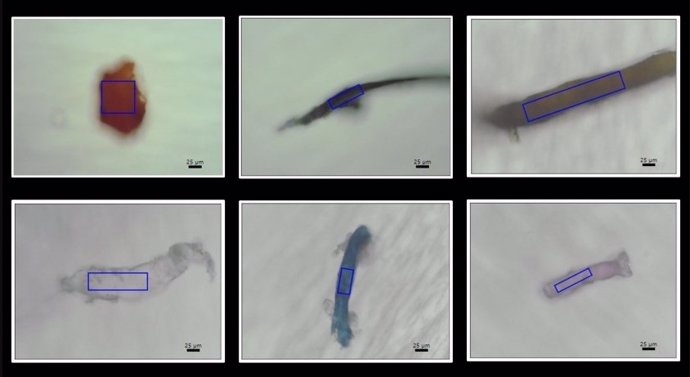Microplastic samples found in corals. A variety of microplastics extracted from corals off the coast of Si Chang Island in the Gulf of Thailand. – KYUSHU UNIVERSITY/ISOBE LAB
September 20 () –
A new microplastic detection technique has discovered that The three parts of coral anatomy (surface mucus, tissue and skeleton) contain this kind of artificial waste.
These findings may also explain the “missing plastic problem” which has baffled scientists, as around 70% of the plastic trash that has entered the oceans cannot be found. The team behind the study hypothesizes that coral may be acting as a ‘sink’ of microplastics by absorbing them from the oceans. Their findings were published in the journal Science of the Total Environment.
Humanity’s reliance on plastics has brought unprecedented convenience to our lives, but it has caused untold damage to our ecosystem in ways that researchers are only just beginning to understand. In the oceans alone, it is estimated that Between 4.8 and 12.7 million tonnes of plastics flow into the marine environment annually.
“In Southeast Asia, plastic pollution has become a major problem. “Altogether, almost 10 million tons of plastic waste are dumped annually, which is equivalent to 1/3 of the world total,” he explains. in a statement Associate Professor Suppakarn Jandang of the Research Institute of Applied Mechanics (RIAM) at Kyushu University and first author of the study. “Some of this plastic ends up in the ocean, where it breaks down into microplastics.”
To study the problem of plastic pollution in Southeast Asia, RIAM partnered with Thailand’s Chulalongkorn University in 2022 to establish the Center for Ocean Plastics Studies. The international institute is led by Professor Atsuhiko Isobe, who also led the research team behind these latest findings.
The team wanted to examine the impact of microplastics on local coral reefs, so focused their fieldwork off the coast of Si Chang Island in the Gulf of Thailand. The area is known for its small coral reefs, as well as being a common area for anthropological studies.
“Coral has three main anatomical parts: the surface mucus, the outer part of the coral’s body; the tissue, which are the internal parts of the coral; and the skeleton, the hard calcium carbonate deposits they produce. Our first step was to develop a way to extract and identify microplastics from our coral samples,” Jandang continued in a statement. “We subjected our samples to a series of simple chemical washes designed to break down each anatomical layer. After each subsequent layer was dissolved, we were able to remove the microplastics from the coral samples. We would filter the content and then work on the next layer.”
In total, they collected and studied 27 coral samples from four species. They found 174 microplastic particles in their samples, most between 101 and 200 *m in size, about the width of a human hair. Of the microplastics detected, 38% was distributed in superficial mucus, 25% in tissue and 37% were found in the skeleton. In terms of microplastic types, the team found that nylon, polyacetylene and polyethylene terephthalate (PET) were the three most common, accounting for 20.11%, 14.37% and 9.77%, respectively, of the identified samples.
These new findings also indicate that coral can act as a “sink” for marine plastic, sequestering plastic waste from the ocean, in the same way that trees sequester CO2 from the air.
“The ‘missing plastic problem’ has been worrying scientists tracking marine plastic debris, but this evidence suggests that corals could be responsible for that missing plastic,” says Jandang. “Since coral skeletons remain intact after they die, these deposited microplastics can potentially be preserved for hundreds of years. Similar to mosquitoes in amber.”
Further studies are still needed to understand the full impact of these findings on coral reefs and the global ecosystem.
“The corals we studied this time are distributed all over the world. To get a more accurate picture of the situation, we need to conduct comprehensive global studies on a variety of coral species,” Isobe concludes. “We also don’t know the effects of microplastics on the health of corals and the reef community in general. There is still much work to be done to accurately assess the impact of microplastics on our ecosystem.”



![[Img #74675]](https://thelatestnews.world/wp-content/uploads/2024/12/They-discover-a-new-class-of-X-ray-sources-in-the-150x150.jpg)









![[Img #74675]](https://thelatestnews.world/wp-content/uploads/2024/12/They-discover-a-new-class-of-X-ray-sources-in-the-300x200.jpg)


Add Comment